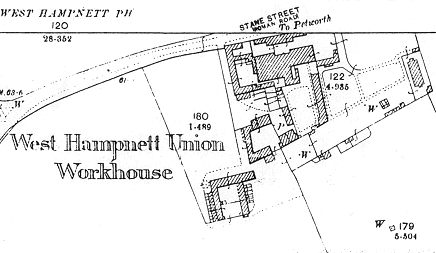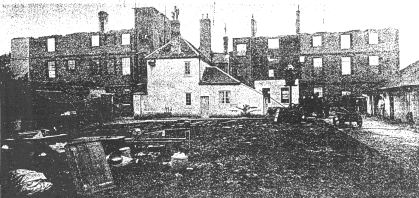Westhampnett (or West Hampnett), Sussex
Up to 1834
A parliamentary report of 1777 listed parish workhouses in operation at Aldingborne (with accommodation for up to 30 inmates), Barnham (14), Midlavant (12), North Mundham (16), Oving (12), and Selsey (35).
Some time after 1782, Westhampnett becme the centre of a Gilbert Union, the other members being Barnham, Binderton, Boxgrove, East Dean, Eartham, Graffham, East Lavant, Mid Lavant, Singleton and West Stoke. The union's workhouse, on Stane Street, Westhampnett, was a old manor house, formerly known as Westhampnett Place.
The workhouse at West-Hampnett, incorporated for the use of 11 parishes, is capable of containing 300 inmates, and is farmed at 3s. 3d. a head; but this varies with the price of wheat. The contract is for 60, and the average number of inmates is 57. I found in it near 20 children, who are taught to read in the house; six of the elder lads go out to farming-work, and earn from 4d. to 6d. a day, which goes as the perquisite of the governor. Able-bodied men are not put into the house, except for a week or so, until they can find work. Nearly all the old people are decayed labourers: one man has been a soldier, but is blind; he has a pension of 5d. a day, which he is allowed to retain. All associate together during the day, but the sexes were stated to be strictly separated at night. No one absents himself without the permission of the governor. The diet is regulated by a table, and consists of six meat dinners, and one suet-pudding dinner weekly.
The parishes of Yapton, Felpham, and Walberton also formed a Gilbert Union in the 1780s, with a workhouse established at Yapton.
A property at the north of Graffham is known as the Old Poor House.
After 1834
Westhampnett Poor Law Union was formed on 25th March, 1835. Its operation was overseen by an elected Board of Guardians, 45 in number, representing its 37 constituent parishes aslisted below (figures in brackets indicate numbers of Guardians if more than one):
Sussex:
Aldingburn (2), Appledram, Barnham, Binderton, Binstead, Birdham (2), Boxgrove (2), East Dean, Donnington, Earnley, Eartham, Eastergate, Felpham, New Fishbourn, Graffham (until 1869), Hunston, West Itchenor, East Lavant, Mid-Lavant, Madehurst, Merston, Middleton, North Mundam, Oving (2), Pagham (2), Rumbold's Wyke, Sidlesham (2), Selsey (2), Singleton, West Stoke, Tangmere, Upwaltham, Walberton (2), Westhampnett, East Wittering, West Wittering, Yapton.
Later Additions: Bognor (from 1894), Portfield (from 1858), Slindon (from 1858).
The population falling within the union at the 1831 census had been 15,017 with parishes ranging in size from Middleton (population 35) to Sidlesham (1,002). The average annual poor-rate expenditure for the period 1831-34 had been £16,457 or £1.1s.11d. per head of the population.
The new Westhampnett Union took over the former Gilbert Union workhouse at Westhampnett. It also briefly made use of the old workhouses at Yapton, Pagham and Aldingbourne. The Westhampnett building was substantially enlarged, for which the Poor Law Commissioners authorized the expenditure of £4,000. The site location and layout can be seen on the 1896 map below.

Westhampnett workhouse site, 1898.
Most of the workhouse building was destroyed by a fire in 1899. Although parts of the structure were four storeys high, the presence of fire escapes resulted in virtually all the 115 inmates escaping without injury. The one fatality was a man in frail health who was described as dying of 'fright'. The inmates were immediately distributed among neighbouring institutions, including Chichester, Westbourne, Midhurst, Petworth, East Preston and Thakeham workhouses, and terms were negotiated for their maintenance with the various unions. The Westhampnett Union continued to pay for people to be maintained at other union workhouses, especially Chichester, and the Westhampnett workhouse was never rebuilt.

Westhampnett workhouse after fire, 1899.
The surviving outbuildings were later used as an isolation hospital but none of these still exist.
Staff
Inmates
Records
Note: many repositories impose a closure period of up to 100 years for records identifying individuals. Before travelling a long distance, always check that the records you want to consult will be available.
- West Sussex Record Office, County Hall, Chichester, West Sussex PO19 1RN. Very few records survive — holdings include Guardians' minutes (1835-1930); etc.
Bibliography
- Higginbotham, Peter Workhouses of London and the South East (2019)
Links
- None.
Acknowledgment
- Thanks to West Sussex Record Office for information on post-fire arrangements.
Unless otherwise indicated, this page () is copyright Peter Higginbotham. Contents may not be reproduced without permission.


